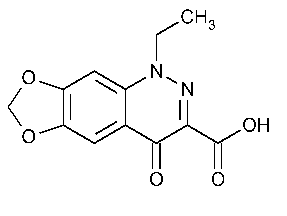Cinoxacin
[1,3]Dioxolo[4,5-g]cinnoline-3-carboxylic acid,1-ethyl-1,4-dihydro-4-oxo-.
1-Ethyl-1,4-dihydro-4-oxo[1,3]dioxolo[4,5-g]cinnoline-3-carboxylic acid [28657-80-9].
»Cinoxacin contains not less than 97.0percent and not more than 102.0percent of C12H10N2O5,calculated on the dried basis.
Packaging and storage—
Preserve in tight containers.
Identification—
A:
Infrared Absorption á197Kñ.
B:
The RFvalue of the principal spot obtained from the Test preparationcorresponds to that obtained from Solution Ain the chromatogram prepared as directed in the test for Related compounds.
Loss on drying á731ñ—
Dry it in vacuum at 60 for 3hours:it loses not more than 1.0%of its weight.
for 3hours:it loses not more than 1.0%of its weight.
Related compounds—
Standard preparations—
Prepare a solution of USP Cinoxacin RSin a mixed solvent prepared by mixing equal volumes of chloroform,dimethylformamide,dimethyl sulfoxide,and nitromethane containing 5mg per mL(Solution A).Prepare a second solution by diluting 1.0volume of Solution Awith the same mixed solvent to obtain 100volumes of solution (Solution B).
Test preparation—
Prepare a solution of Cinoxacin in the same mixed solvent used for the Standard preparations,containing 5mg per mL.
Procedure—
In a suitable chromatographic chamber arranged for thin-layer chromatography and lined with paper,place a volume of a solvent system consisting of a mixture of acetonitrile,water,and ammonium hydroxide (105:30:7.5)sufficient to develop the chromatogram,cover,and allow to equilibrate for 30minutes.Apply 10-µLportions of Solution A,Solution B,and the Test preparationto a suitable thin-layer chromatographic plate (see Chromatography á621ñ)coated with a 0.25-mm layer of chromatographic silica gel mixture.Dry the plate,and apply three additional 10-µLportions of each solution at the corresponding initial locations.Dry the plate thoroughly after each application,and develop the chromatogram until the solvent front has moved to the top of the plate.Remove the plate from the developing chamber,and allow the solvent to evaporate.View the plate under short-and long-wavelength UVlight:the RFvalue of the principal spot obtained from the Test preparationcorresponds to that obtained from Solution A,and no spot obtained from the Test preparation,other than the principal spot,is larger or more intense than the principal spot obtained from Solution B(1.0%).
Organic volatile impurities,Method IVá467ñ:
meets the requirements.
Assay—
Sodium borate solution—
Dissolve 38.1g of sodium borate in water to make 1000mL.
Internal standard solution—
Prepare an aqueous solution containing 2mg of sulfanilic acid per mLand 5.0mLof Sodium borate solutionin each 100mL.
Mobile phase—
Dilute 100.0mLof Sodium borate solutionand 0.426g of sodium sulfate with water to 1000mL,mix,and degas.[NOTE—The quantity of sodium sulfate may be varied to meet System suitability requirements,and to provide a suitable elution time.]
Standard preparation—
Dissolve an accurately weighed quantity of USP Cinoxacin RSin Sodium borate solutionto obtain a solution having a known concentration of about 1mg per mL.Transfer 5.0mLof this solution and 5.0mLof the Internal standard solutionto a 100-mLvolumetric flask,dilute with water to volume,and mix.The Standard preparationcontains about 50µg of USP Cinoxacin RSper mL.
Assay preparation—
Transfer about 50mg of Cinoxacin,accurately weighed,to a 50-mLvolumetric flask,dissolve in Sodium borate solution,dilute with the same solvent to volume,and mix.Transfer 5.0mLof this solution and 5.0mLof the Internal standard solutionto a 100-mLvolumetric flask,dilute with water to volume,and mix.
Chromatographic system
(see Chromatography á621ñ)—The chromatograph is equipped with a 254-nm detector and a 1.8-mm ×1-m column that contains packing L12.The flow rate is about 1mLper minute.Chromatograph five replicate injections of the Standard preparation,and record the peak responses as directed under Procedure:the relative standard deviation is not more than 2.0%,the resolution factor between cinoxacin and sulfanilic acid is not less than 4.4,and the tailing factor for the cinoxacin peak is not more than 2.1.
Procedure—
Separately inject equal volumes (about 1.0µL)of the Standard preparationand the Assay preparationinto the chromatograph,record the chromatograms,and measure the responses for the major peaks.The relative retention times are about 2.2for sulfanilic acid and 1.0for cinoxacin.Calculate the quantity,in mg,of C12H10N2O5in the portion of Cinoxacin taken by the formula:
C(RU/RS),
in which Cis the concentration,in µg per mL,of USP Cinoxacin RSin the Standard preparation,and RUand RSare the ratios of the peak response of cinoxacin to the peak response of sulfanilic acid obtained from the Assay preparationand the Standard preparation,respectively.
Auxiliary Information—
Staff Liaison:Behnam Davani,Ph.D.,MBA,Senior Scientist
Expert Committee:(PA7)Pharmaceutical Analysis 7
USP28–NF23Page 475
Phone Number:1-301-816-8394
